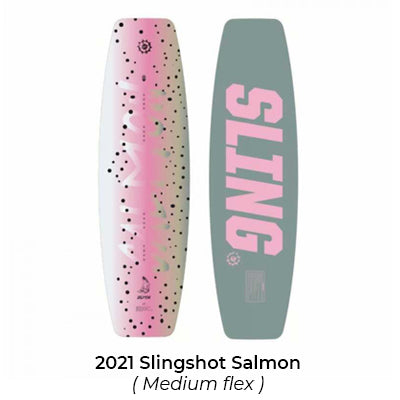how to choose your wakeboard for a wakepark ?
Posted by IAN CURRY-LINDAHL

Back in the day, Wakeboard was all about boat riding. Today it became different because for the past 10/20 years, wakeparks have started to be built all around the globe and they give better accessibility to the large public to try wakeboarding. Offering features and no fuel, they quickly became the mainstream in many countries of the world.

In the beginning, we were seeing a lot of stiff boards as that's what used to be ridden behind a boat with integrated fins and thick channels at the wakeparks.
But with the evolution of rails and kickers that quickly became the main discipline in wakeparks, New designs, material and shapes have created better boards for this style of riding. They call them the " flex boards"
A flex board is going to be more playful on the water and rails with less heavy impact in the landings. But too much flex will remove some other advantages you would find on a stiffer board, as the pop for instance. Depending on how you are looking to ride like, there is a lot of variety in the strength of the flexes and shapes of a flex wakeboard.
Winching boards require the same specification as a cable board.

A wakeboard shape:
If you are a learner, we recommend you to start with something big and that floats a lot until you are comfortable enough to lap around the cablepark before riding an expert board.
The length of your board
Riding long or a shortboard depends obviously on your sizes and weight but also and most commonly on the style of riding you are looking for.
Riding a small board will provide good control in your movement and rotations but it can feel very slow and deep in the water, which will make you frustrated most of the time. The decreased surface area also makes landings harder and the nose may tend to dig in, which can cause front edges (the worst nightmare of every wakeboarder!)
With more board surface on the water from a big board, you'll feel much faster on the water. and landing will be softer. It will be harder to spin or do inverts though.
They also are the better ones to begin with.
In the past few years, Professional wakepark riders tend to ride bigger boards. We can actually see most of the major brands releasing more bigger sizes every season.
The rocker of you board
- More forgiving
- Faster
- Softer landings
- Better control on rails
- doesn't stick to the line as well as a 3 stages
- more slippery in the landing.

A 3-stage rocker gives you a better edge while resisting against the cable. Boards with 3-stage rocker have a flatter center spot which makes the impact of landings more intense and gives a slight sluggish feel after landing.
Advantages:
- Great performance for technical riders
- better edge
Inconvenient:
- harder landings
- slower on flat
- less control on rails

Advantages:
- Advantages of both but not as much as a continuous or a 3 stages.
Inconvenient:
- Inconvenient of both but not as much as a continuous or a 3 stages.







